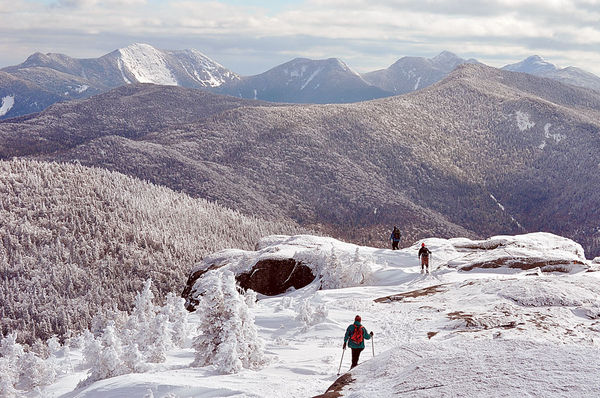Stay safe outdoors

Hikers on snowshoes cross Cascade Mountain in November 2014, with the Great Range of the High Peaks in the background. (News photo — Mike Lynch)
The state Department of Environmental Conservation recently reminded visitors to the Adirondack Park Forest Preserve and all state lands to recreate safely and responsibly and practice Leave No Trace this winter.
–
Plan ahead and prepare
–
– Proper planning is vital to a safe winter adventure. Know personal limits, set realistic goals, and choose an experience appropriate for everyone in the group. Research trails and routes before setting out and contact DEC or other knowledgeable parties with questions.
– Winter weather can change rapidly. Prepare for every occasion by bringing the 10 Hike Smart NY essentials, including food, water, navigation, warm layers, snowshoes and traction devices, a headlamp, first-aid kit, emergency kit, emergency shelter, and matches or a lighter. Stay up to date with current weather reports leading up to a trip. If the forecast calls for harsh conditions, consider rescheduling.
– Make a timeline, including a turnaround time, and stick to it. Always leave trip plans with someone who will call for help if you don’t return on time. For more tips on preparing for a safe outdoor winter experience, visit DEC’s winter hiking safety page.
–
Travel and camp on durable surfaces
–
– Stick to designated trails and campsites as much as possible. Skis or snowshoes are recommended whenever there is significant snowpack and are required in the Eastern High Peaks when snow depths reach eight inches. Snowshoes make walking in deep snow easier and help prevent postholing, the act of creating deep holes in the snow with bare boots. Remember that snow will likely be deeper at higher elevations. Use traction devices, such as crampons or microspikes, to travel safely on icy trails.
–
Dispose of waste properly
–
– Pack out garbage, food scraps, broken gear, and pet waste. Dispose of trash in a designated can at the trailhead or at home. “Go before you go” and use toilets or outhouses whenever possible. While the ground is frozen, making cat holes hard to dig, be prepared to pack out poop where toilets aren’t available.
–
Leave what you find
–
– Leave trail signs and markers so others can find their way. Leave historic artifacts and natural features for others to enjoy. Don’t carve or graffiti rocks, trees or backcountry structures.
–
Minimize campfire impacts
–
– Confirm that fires are permitted before you build one. Use designated fireplaces whenever possible and only burn dead and downed wood. When you’re done with the fire, extinguish it completely. Never leave a fire unattended or have a fire inside a structure such as a lean-to or tent.
–
Respect wildlife
–
– Appreciate wildlife from a distance. Don’t follow, approach or feed them. Human food can harm wildlife, and feeding animals can create bad habits that lead to dangerous interactions, unnatural habituation, and unsustainable dependency.
–
Be considerate of other visitors
–
– Help all visitors have a safe and enjoyable experience by following winter trail etiquette. Wear snowshoes or skis on snowy trails to avoid post-holing and separate ski and snowshoe tracks when possible. Yield to downhill skiers, keep to the right side of the trail, and use the left to pass. Snowmobile riders are reminded to respect posted signage and slow down when passing pedestrians or traveling through densely populated areas.

